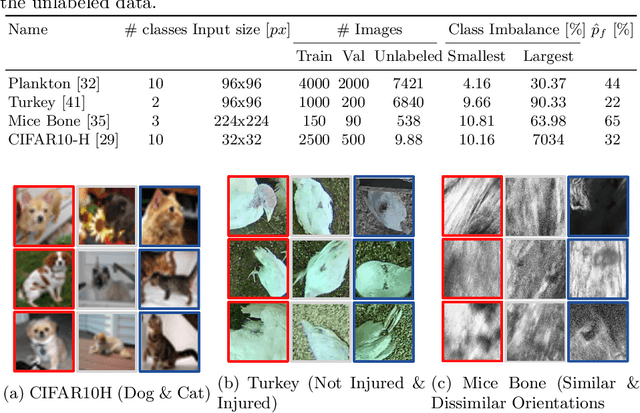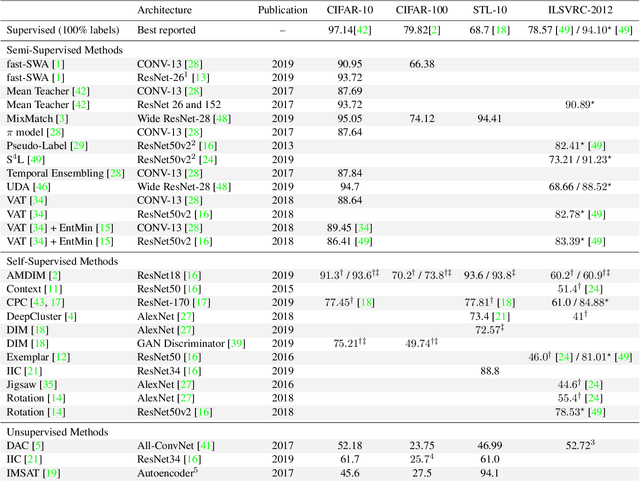Simon-Martin Schröder
Fuzzy Overclustering: Semi-Supervised Classification of Fuzzy Labels with Overclustering and Inverse Cross-Entropy
Oct 13, 2021



Abstract:Deep learning has been successfully applied to many classification problems including underwater challenges. However, a long-standing issue with deep learning is the need for large and consistently labeled datasets. Although current approaches in semi-supervised learning can decrease the required amount of annotated data by a factor of 10 or even more, this line of research still uses distinct classes. For underwater classification, and uncurated real-world datasets in general, clean class boundaries can often not be given due to a limited information content in the images and transitional stages of the depicted objects. This leads to different experts having different opinions and thus producing fuzzy labels which could also be considered ambiguous or divergent. We propose a novel framework for handling semi-supervised classifications of such fuzzy labels. It is based on the idea of overclustering to detect substructures in these fuzzy labels. We propose a novel loss to improve the overclustering capability of our framework and show the benefit of overclustering for fuzzy labels. We show that our framework is superior to previous state-of-the-art semi-supervised methods when applied to real-world plankton data with fuzzy labels. Moreover, we acquire 5 to 10\% more consistent predictions of substructures.
* Source code: https://github.com/Emprime/FuzzyOverclustering Datasets: https://doi.org/10.5281/zenodo.5550918. arXiv admin note: substantial text overlap with arXiv:2012.01768
S2C2 - An orthogonal method for Semi-Supervised Learning on fuzzy labels
Jun 30, 2021



Abstract:Semi-Supervised Learning (SSL) can decrease the amount of required labeled image data and thus the cost for deep learning. Most SSL methods only consider a clear distinction between classes but in many real-world datasets, this clear distinction is not given due to intra- or interobserver variability. This variability can lead to different annotations per image. Thus many images have ambiguous annotations and their label needs to be considered "fuzzy". This fuzziness of labels must be addressed as it will limit the performance of Semi-Supervised Learning (SSL) and deep learning in general. We propose Semi-Supervised Classification & Clustering (S2C2) which can extend many deep SSL algorithms. S2C2 can estimate the fuzziness of a label and applies SSL as a classification to certainly labeled data while creating distinct clusters for images with similar but fuzzy labels. We show that S2C2 results in median 7.4% better F1-score for classifications and 5.4% lower inner distance of clusters across multiple SSL algorithms and datasets while being more interpretable due to the fuzziness estimation of our method. Overall, a combination of Semi-Supervised Learning with our method S2C2 leads to better handling of the fuzziness of labels and thus real-world datasets.
Beyond Cats and Dogs: Semi-supervised Classification of fuzzy labels with overclustering
Dec 03, 2020



Abstract:A long-standing issue with deep learning is the need for large and consistently labeled datasets. Although the current research in semi-supervised learning can decrease the required amount of annotated data by a factor of 10 or even more, this line of research still uses distinct classes like cats and dogs. However, in the real-world we often encounter problems where different experts have different opinions, thus producing fuzzy labels. We propose a novel framework for handling semi-supervised classifications of such fuzzy labels. Our framework is based on the idea of overclustering to detect substructures in these fuzzy labels. We propose a novel loss to improve the overclustering capability of our framework and show on the common image classification dataset STL-10 that it is faster and has better overclustering performance than previous work. On a real-world plankton dataset, we illustrate the benefit of overclustering for fuzzy labels and show that we beat previous state-of-the-art semisupervised methods. Moreover, we acquire 5 to 10% more consistent predictions of substructures.
MorphoCluster: Efficient Annotation of Plankton images by Clustering
May 04, 2020



Abstract:In this work, we present MorphoCluster, a software tool for data-driven, fast and accurate annotation of large image data sets. While already having surpassed the annotation rate of human experts, volume and complexity of marine data will continue to increase in the coming years. Still, this data requires interpretation. MorphoCluster augments the human ability to discover patterns and perform object classification in large amounts of data by embedding unsupervised clustering in an interactive process. By aggregating similar images into clusters, our novel approach to image annotation increases consistency, multiplies the throughput of an annotator and allows experts to adapt the granularity of their sorting scheme to the structure in the data. By sorting a set of 1.2M objects into 280 data-driven classes in 71 hours (16k objects per hour), with 90% of these classes having a precision of 0.889 or higher. This shows that MorphoCluster is at the same time fast, accurate and consistent, provides a fine-grained and data-driven classification and enables novelty detection. MorphoCluster is available as open-source software at https://github.com/morphocluster.
A survey on Semi-, Self- and Unsupervised Techniques in Image Classification
Feb 20, 2020



Abstract:While deep learning strategies achieve outstanding results in computer vision tasks, one issue remains. The current strategies rely heavily on a huge amount of labeled data. In many real-world problems it is not feasible to create such an amount of labeled training data. Therefore, researchers try to incorporate unlabeled data into the training process to reach equal results with fewer labels. Due to a lot of concurrent research, it is difficult to keep track of recent developments. In this survey we provide an overview of often used techniques and methods in image classification with fewer labels. We compare 21 methods. In our analysis we identify three major trends. 1. State-of-the-art methods are scaleable to real world applications based on their accuracy. 2. The degree of supervision which is needed to achieve comparable results to the usage of all labels is decreasing. 3. All methods share common techniques while only few methods combine these techniques to achieve better performance. Based on all of these three trends we discover future research opportunities.
 Add to Chrome
Add to Chrome Add to Firefox
Add to Firefox Add to Edge
Add to Edge